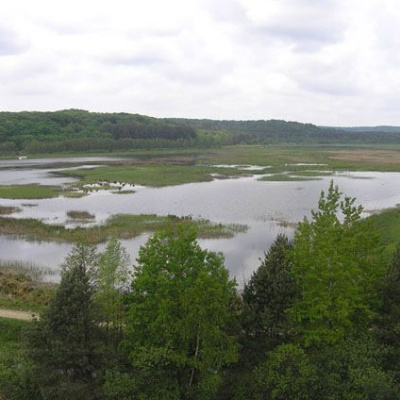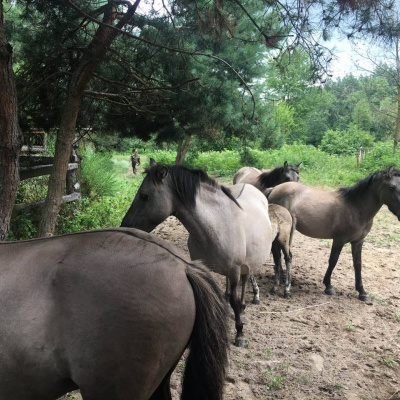Yavoriv National Nature Park
Yavoriv National Nature Park is a national nature park in Ukraine, within the Yavoriv district of Lviv region. It was created to preserve, restore and rationally use typical and unique forest-steppe landscapes and other natural complexes in the area of the Main European Watershed.
The park was established on July 4, 1998, by Presidential Decree No. 744 on the basis of the Yavoriv Regional Landscape Park (which had existed here since 1996 on an area of 4190.0 hectares) and the adjacent territories of the Starychiv and Mageriv military forestries. The total area of the national park is 7108.0 hectares, of which 2915.0 hectares are provided for permanent use, and 4193.0 hectares are included in the park without being seized from land users.
Yavoriv National Nature Park is located on the territory of the Ukrainian Roztochchia, one of the most interesting physical and geographical areas of Western Ukraine. The Ukrainian Roztochchia is a narrow (up to 25 km) 75 km long hilly ridge that rises sharply above Little Polissia in the north. In its southeastern part lies the Main European Watershed, on the slopes of which rivers belonging to the basins of two seas - the Black and Baltic.
The park's territory stretches in a kind of crescent from the village of Vereshchytsi in Yavoriv district to the village of Krekhova in Zhovkva district. Its length from west to east is 12-13 km, and from north to south - from 2.5 to 12 km. To the south, the park borders the Roztochia Nature Reserve, to the north it borders the training field of the Yavoriv Training Center of the Defense Forces of Ukraine, known as the Yavoriv Military Training Area, and the Ravske Roztochia Regional Landscape Park.
The following settlements are located near the park: Vereshchytsia, Starychi, Shklo, Novoyavorivsk, Lelekhivka, Ivano-Frankove, Stavky, Serednyi Horb, Verkhutka, Lozyno, Dubrovytsia, Mlynky, Papirnia, Fiyna, Kozulka, Krekhiv. In the western part of the park there is the Vereshchytsia River, which flows into the Dniester. Within the park, the left tributaries of the Vereshchytsia River - the Stavchanka and Stara Rika rivers - originate. In the north, there are the sources of the Derevnyanka and Svynya rivers (the Western Bug River basin).
According to the functional zoning, the territory of the park is divided into a protected area of 661.6 hectares, a regulated recreation area of 1254.1 hectares, a stationary recreation area of 30.2 hectares, and an economic area of 5162.1 hectares. According to the physical and geographical zoning, the territory of the park belongs to the Roztotskyi district of the Roztotsko-Opilskyi region of the Western Ukrainian forest-steppe province. There are no settlements on its territory, so the anthropogenic impact on natural ecosystems is insignificant.
The climate of this area is typical of Roztochia, which is located in the border zone of influence of Atlantic air currents from the west and continental air currents from the east. In general, the climate is moderately humid. The average annual rainfall is 700 mm, and the average annual temperature is +7.5 °C. Most precipitation falls in June-July, and the least in January-February. The warmest month of the year is July (+17.7 °C), and the coldest is January (-4.2 °C). Annual temperature fluctuations are insignificant and reach 21.9 °C.
The relief of the park is a combination of steeply sloping hills, plateau-like uplands, wide inter-ridge depressions, terraces and river floodplains. The elevations are cut by deep ravines (up to 80-100 meters in some places), which the locals call "debry". The highest point on the territory of the park is an unnamed height of 403.6 m, located to the west of the village of Mlynky (part of the village of Dubrovytsia). Among the other peaks are: Bulava (397 m), Kubin (378 m), Berezniaky (378 m), Boltova Hora (360 m), Vovsiana Hora (387 m). Numerous picturesque hillocks with rocky outcrops of massive limestone and calcareous sandstone give the park its unique originality. There are small caves, sinkholes and rods of karst origin. The windswept hills and dunes covered with pine forests are also interesting.
The most widespread in the park are the low sod, middle sod, and deep sod-weakly podzolized sandy soils on Quaternary and Tertiary sands. On clayey rocks, there are low-aged, slightly podzolized clay-sandy soils underlain by limestone eluvium, and in the depressions, peaty-gley soils on alluvial deposits are common.
The flora of Yavoriv National Nature Park includes about 700 species of vascular plants. Of these, 18 species are listed in the Red Data Book of Ukraine: Common lamb's-eye, summer plain, floating salvinia, large-flowered bulrush, long-leaved bulrush, common nesting plant, ovate cuckoo's tears, broad-leaved bark, double-leaved love, green-flowered love, May's finger-root, spotted finger-root, three-cut corkscrew, true cuckoo's slippers, common snowdrop, spring snowdrop, forest lily, dioecious valerian. The park's territory, in the Bila Skelya tract, is home to the easternmost occurrence of sand fescue in Ukraine. Among the species that can be considered rare for Roztochia, the park's territory includes the spiky multirow, mountain onion, branched vetch, forest anemone, ringed bush, gray alder, Polish marigold, etc. More than 200 species of medicinal plants grow in the park.
In addition, among the rare species found in the park, 12 species (all orchids and snowdrop) are protected by the Convention on International Trade in Endangered Species of Wild Fauna and Flora (CITES), and 2 species (floating salvinia and true cuckoo's slipper) are protected by the Convention on the Conservation of Wild Flora and Fauna and Natural Habitats in Europe (Bern Convention).
Yavoriv National Nature Park, as well as Roztochia in general, is characterized by high forest cover. The most common forests here are hornbeam-oak, pine-oak, pine forests, and alder forests in the lower elevations. Beech forests grow near the Eastern European border of the range and are confined to hilly landscapes. Interesting are the island relict centers of spruce, fir, and sycamore that have been preserved at the northeastern limit of their range. The relics of the Middle Holocene include beech and pine forests. Grass vegetation occupies much smaller areas and was formed on natural meadows and former pastures and settlements, as well as on the banks of rivers and canals.
The region marks the floristic border of Central and Southeastern Europe, accompanied by the transition of broadleaf forests to forest-steppe. The eastern border of the distribution of rock oak, juniper, beech, the southeastern border of scots pine, and the northeastern border of white fir. The Carpathian flora is represented by spruce and, especially, ferns. There are relict remnants of steppe vegetation on rocky outcrops. On the territory of the national park there are 8 communities included in the Green Book of Ukraine: a subformation of beech-pine forests, groups of associations of green-moss and blueberry pine forests, oak-pine hazel forests, oak-hickory forests, juniper pine forests, etc. The beech forests on the northern border of the range, as well as fragments of gray alder forests, ash forests, and some other forests can be considered rare for the region.
In total, 9 species of animals listed in the European Red List, 34 species listed in the Red Book of Ukraine and 146 species of animals subject to special protection under the Bern Convention have been registered in the park.
Invertebrates. The insect fauna is particularly rich among invertebrates. The following Red Data Book species were found in the national park and its environs: musk mustache, moss bumblebee, mahogany moth, mnemosyne, poplar moth, large moth, Heraeus haymaker, birch endromis, order raspberry ribbonworm, small saturnia, and red saturnia.
The total number of registered species of vertebrates today is 289 species. The park protects 24 species of fish, 11 species of amphibians, 6 species of reptiles, 200 species of birds, and 48 species of mammals.
Amphibians. Reptiles. Among the representatives of herpetofauna, the gray toad, lake and grass frogs are numerous, while the common ones are the sharp-toothed frog, frog, quick and viviparous lizards, and the common snake. Less common are the common viper, brittle spinneret, common and crested newts. Very rare species are the water urchin and the copperhead, which are listed in the Red Book of Ukraine.
Birds. The park's avifauna is dominated by forest species. The most numerous are small rowan birds - chaffinch, goldfinch, black-headed sparrow, black and yellow-browed sheepdogs, white-necked flycatcher, nuthatch, blackbird and songbird. Buzzard is the most common bird of prey. The avifauna of oak and beech-oak-pine forests is the richest in terms of composition and number. In pine forests, titmice are more common: great, blue, and black-headed titmouse, as well as yellow-headed kingfisher, and various species of woodpeckers. The adjacent ponds are home to a wetland birdlife complex dominated by coot, mallard, mallard, great crested grebe, and common martin. Among the birds listed in the Red Book of Ukraine, the park and its surroundings are the following: lesser cormorant, mowing heron, black stork, white-eyed heron, eagle osprey, white-tailed eagle, lesser spotted eagle, snake-eater, red-breasted vulture, field harrier, gray crane, great and medium culm, pond pipistrelle, owl, long-tailed owl, gray shrike.
Mammals. Among the mammals of the park, the highest species diversity is characterized by rodents, the most numerous are the yellow-breasted mouse and the red mole. Among the game animals, there are forest otter, gray hare, forest marten, forest ferret, wild pig, European chamois, Ussuri raccoon, red fox, and among the Red Book species - river otter, European mink, ermine. The park is occasionally visited by moose, and red deer are sometimes seen in the vicinity. In recent years, the number of wolves has increased significantly. The caves and other underground shelters are of exceptional importance for the conservation of bat biodiversity, including the Red Book bats, such as the European broad-eared bat, ciliated bat, and long-eared bat. In 2005, the European beaver was first discovered in the upper reaches of the Vereshchytsia River.
The region in which Yavoriv National Nature Park is located is extremely rich in archaeological, historical and cultural monuments. The region is home to princely-era settlements and a number of ancient human sites. The following historical and architectural monuments are located on the territory adjacent to the national park: St. Nicholas Basilian Monastery in Krekhiv (XVII-XVIII centuries), Trinity Church with a bell tower (1614) and the Church of the Ascension (1831) in Ivano-Frankove, Assumption Church (1739) in Lelekhivka village. Lelekhivka, the cave on Stradetska Hill and the Church of the Assumption of the Blessed Virgin Mary (XVIII century) in Stradch, the ruins of St. Michael's Church in the former village of Vyshenka Velyka on the territory of the landfill, etc. Among the forest areas, there are often picturesque glades and remnants of orchards - a memory of former villages and hamlets evicted during the creation of the landfill.
There are eight recreation centers in the surrounding area, as well as the Shklo and Nemyriv balneological resorts with healing hydrogen sulfide mineral water called Naftusia. The Yavoriv National Nature Park has significant recreational potential for the development of ecological, cultural, sacred, and sports (horseback riding, cycling, and skiing) tourism, and in the adjacent areas - skilled tourism (hunting, fishing). The surrounding settlements have favorable conditions for the development of agritourism.
The Roztochany region has long been famous for its folk crafts, such as wood carving, pottery, blown glass and beadwork, Yavoriv Easter eggs and embroidery. Near the Yavoriv Park, in the town of Zhovkva, there is a state historical and architectural reserve with a whole complex of cultural monuments.
There are 4 comprehensive bus and pedestrian routes in the park: "Stradch - Black Lakes", "From Yanov to Krekhiv", "Confession of Time" (Sheptytsky family nest), "Yavoriv Training Ground - Past and Present", as well as 4 hiking ecological and educational trails: "Ivan Franko Trail, Lelekhivka, Vereshchytsia, and Doves. The park's stationary recreation area has places for mass recreation of tourists: summer recreation sheds, barbecues, and places for making fires. The reservoirs have conditions for amateur fishing, a beach, and the use of watercraft.





